Testing Days
The line was
used for numerous tests, most of which are lost in the mists of time, but one or two stick in the memory.
Photos are the author's unless otherwise
credited
ATO
BR's automatic train operation system (BRATO), which used the
ex-Scottish Region 2-car battery railcar (re-numbered RDB 975003/4 and named
Gemini) as its test vehicle, was extensively tested here between 1968 and 1975. Known as the 'wiggly wire' system this was the forerunner of what was developed by many other companies into what is now known as Automatic Train Protection (ATP).
The original wiggly-wire was laid on the Down line between Friargate and Etwall stations - a
distance of approx. five miles.
|
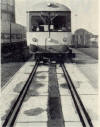 |
A trial system laid in the yard
at the RTC pictured on March 10th 1965, with RDB999507 the
Elliott track recording car
in the background. The wire was bonded to plastic sheets fixed to the ground. Author's collection |
|
 |
Here's a close up of the system
installed on a short length of track circa 1967. The wire here is stapled to
plywood boards fixed to the sleepers Author's collection |
|
 |
The unique battery railcar Gemini
(Lab 16 RDB975003 and RDB975004) was used exclusively by the Train Control
Group and is shown
just west of the Mickleover depot site heading towards Egginton Jcn,
sometime in the late 1970s. It was
originally BR Sc79998 and Sc79999 and was used on the Ballater branch where it began its working life in
1958 and was acquired by the R&DD in 1966. It is now at the Deeside Railway where its restoration is being completed
having been originally undertaken on the East Lancs Railway. For more
information look on the Deeside
Railway site - and for some original pictures in BR service look
here.
Author's collection
|
|
 |
First day of operation at
Ballater in 1958 complete with pipers
BR official |
|
 |
A nice colour shot of the 2-car
set Gemini at Bury on the ELR on 5th October 1991during its
restoration
Simeon Gaskell |
|
 |
This is an early train simulator
and driver's cab display (right) under test in the lab. Author's collection |
|
 |
The view from the cab with the
extra equipment visible on the right hand side. I don't think BR drivers
wore sports jackets when driving so I suspect it's a member of the
Research team at the controls - circa
1970 Author's collection |
|
 |
Another view with a slightly
different set up - the scale I assume to be 'distance to target'
indication - note that the same piece of track is being traversed. Yes
it's the same sports jacket too! The location is at the top of the
climb past the present Mackworth estate and the bridge in the distance is
one the author used to play on as a child! (and the sun's shining!) Author's collection |
|
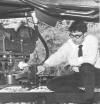 |
And a technician adjusts the underframe receiving equipment
Author's collection |
|
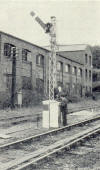 |
The trackside equipment was
positioned in the S&T location cabinets alongside the line - which at this
stage was still open to traffic. There was a tone generator linked to the
signal which altered depending upon the aspect.
This is outside one of the GNR warehouses at the
Friargate end of the line
Author's collection |
Linear Motor
Further tests were carried out with a linear motor, which was mounted on a Class 101 DMU. The trials were to evaluate the difficulties of laying the aluminium/steel
reaction rail, which the linear motor would utilise, down the centre of the track. The motor never provided propulsion but was
used to test the practicalities of the system.
|
 |
This is the Class 101 DMU in
mid 1975 pictured standing on a piece of track equipped with the linear motor test
facility.
Author's collection
|
|
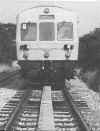 |
Around 260 yards of the line were equipped with the
aluminium/steel reaction rail including joints and crossings.
Author's collection
|
Hydraulic Drive DMU
Single car unit No: RDB 975385 (formerly M55997 a
Cravens-built parcels car) was converted as a test bed for hydrostatic
transmission in 1974 and was known as Lab 9
'Hydra'. Although it was tested at Old Dalby on a number of occasions it is pictured here
at Mickleover, which was a convenient line due to its proximity to Derby
|
 |
This picture of Hydra was taken
in August 1984 adjacent to Etwall station - the A50 road ran over the
bridge in the background. It is adjacent to this spot that the new A516
Etwall by-pass road
divides the remains of the track bed
Tony Woof |
|
 |
Hydra
sits on the main test line
just under the overbridge adjacent to the depot at Mickleover. Note the
'wiggly wire' ATO system in the four foot
Colin Marsden |
Track Defect Tests
Further wagon testing conducted at the track included running
a test vehicle over a known track defect. A length of the line was connected via turnbuckles to the adjacent line
which was braced with additional lengths of rail for stability. These
turnbuckles could be moved by the application of a large spanner to introduce a kink into the running line.
This feature was introduced in the early days of the Research Department and was
used extensively during pioneering investigations into wagon suspensions and
wheel/rail interaction.
|
 |
The test site - running line on
the right. Note the extra rails in the LH four foot and the turnbuckles
connecting the two running lines.
Author's Collection
|
|
 |
A test train with the DM&EE's Test Car 1,
ADW150375 the former WR autocoach, and a 21 ton hopper wagon pass the track defect site on the Mickleover test track
on 25th July 1974. |
|
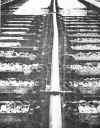 |
A closer view of the
misalignment
Author's Collection
|
|
 |
Seconds
later the test train is past and heading for Egginton Jcn |
Wind Tunnel
Later a miniature wind tunnel was constructed on the track bed of the old
Up line in which aerodynamic modelling in connection with research into shock waves caused by the Advanced Passenger Train and high speed trains was carried out.
|
 |
The miniature wind tunnel
Colin Marsden |
|
 |
Inside the miniature wind tunnel
BR Official |
Railbus RB004
|
 |
Railbus RB004 sits alongside the
wind tunnel at Mickleover during its commissioning tests in the spring of
1984. This vehicle is preserved at
Telford Steam
railway. Look here
for a picture of the unit at Telford and
here
for another at Shildon.
Basil Hancock |
Class 151 trials
During the acceptance testing of the
Class 151
Metro-Cammell built Sprinter units in the summer of 1985, the Twin Disc gearboxes proved to be rather troublesome. Their 'hot shift' characteristic imparted unacceptable longitudinal shocks to the trains and hence to the passengers and made for an uncomfortable journey.
In order to address the problem the first unit
spent a few weeks at the test track where the Twin Disc engineers carried out numerous adjustments until an acceptable gear change characteristic was achieved.
|
 |
In March 1985 Metro-Cammell-built
DMU 151001 is pictured
passing Stenson Jcn being loco-hauled en route to Mickleover
John Tuffs |
|
 |
The prototype Metro-Cammell Sprinter No: 151001
stands at the Mickleover end of the track in March 1985. The wind tunnel is to
the left of the unit. |
|

|
Unit 151001 rests outside the workshop at Mickleover during its shakedown running at the test track in the spring of 1985. The workshop, which housed the battery railcar etc is behind the unit and the original GNR station can be seen in the left background.
Matt Harrison |
Speed Limit Signs Evaluation
The prototype
Class 150 Sprinter DMU's also visited the site and one of the tests which they carried out was the evaluation of the new reflective speed limit trackside signs in the mid 1980's.
As most modern traction was then being fitted with high intensity headlights the
cut-out type speed signs which had served the railway for many years were to be replaced with more modern
reflective devices. These of course are subject to being obliterated by
graffiti. Progress?
These trials were carried out at night, much to the annoyance of the locals, no doubt.
Class 60 commissioning
The early class 60 locomotives were commissioned at
Mickleover (and at Old Dalby) over a lengthy period.
|
 |
Here is 60015 in the company of
an unidentified sister loco about to depart RTC for Mickleover
Author's Collection
|
|
 |
60001 outside the workshop at
Mickleover in the late 1980s. Note the battery railcar in the shed and the
Networker prototype behind the loco made up from redundant stock from the
class 210 DEMU. Paul Hadfield |
|
 |
60001 at Egginton Jcn with TC6
about to come off the test track - photo taken from signalbox
Unknown |
Class 155 Publicity shots
The Leyland-built class 155 DMU visited the test
track for some publicity shots prior to entering service
|
 |
Leyland Class 155 unit 155 301 at the top of
the straight at Mickleover. Next to the train is the original track - known as
the 'Long Siding'
Author's Collection
|
|

|
Another shot - this time positioned under overbridge
116 at the top of the straight
Author's Collection
|
|
 |
Stabled at Mickleover next to the shed with the
Eliot track recording car behind Chris
Ward |
Derailment Detection Device
At the end of 1974 the line was used to demonstrate a 'derailment
detection device'. This was thought necessary since a large number of 4-wheeled vacuum braked wagons were still in use on BR and derailments were not uncommon.
If after derailment the brake pipe remained complete, the derailed wagons could run
for miles damaging the track and often the loco crew didn't even know they had a derailed wagon, the power of the modern diesels was unaffected by the extra drag. The device was connected to the braking system and consisted of
one ceramic pipe above the vehicle's leaf springs and one attached to the
axlebox. When the vehicle
de-railed the gap above the spring was closed thereby breaking the element and venting the brake
pipe, alternatively the one on the axlebox would come into contact with the rail
head. Although successfully tested by deliberately de-railing a van the system was not
really a practical proposition and was never developed any further.
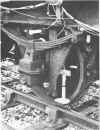 |
The devices are shown attached
to the suspension of a 10ft wheelbase 'Vanfit'. The white parts are the
frangible elements, one between the spring buckle and the solebar and the
other placed so as to break when it came into contact with the rail. All a
bit unbelievable after 40 years
Author's Collection
|
 |
The switch was designed such
that when a bar fixed to the leading wagon came into contact with the
lever it would open thereby derailing the trailing wheelset. It worked!
Author's Collection
|
 |
The aftermath: The van derailed
and the brake pipe vented. All filmed from the train and from the
trackside.
Author's Collection
|
Auto-wagon
In the summer of 1971 an unusual development was tested in the shape of a vehicle which carried a single container and which was self-propelled. Known as the 'Autowagon' it was proposed that the vehicle would be able to park itself, and thereby save on motive power but
not surprisingly the idea didn't take off. It did feature on the TV
programme 'Tomorrow's World' but was pushed into the shot by the 08
shunter giving the impression that it was self-propelled.
|
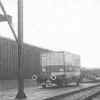 |
The 'Autowagon' is seen here approaching the
unloading facility alongside the workshop at Mickleover
Author's collection
|
Remote controlled shunter
Another idea trialled at Mickleover was a
radio-controlled class 08 350HP shunting loco. Withdrawn in 1978 and formerly
08267 it was used by the Train Control Group and named 'Pluto'. Although it was
taken into stock as RDB968020 it was later re-numbered 97 801.
|
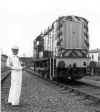 |
This shot is taken outside the Depot
looking west
Colin Marsden |
Side Pull Tests
Tests to assess the lateral stiffness of
vehicle's suspension were undertaken at various places including the test track.
|
 |
An interesting shot from 1976
taken from the old signal box base. This shows a side-pull test under way
next to the workshop using the Warflat sleeper loading vehicle RDW160207.
It is loaded with the rail-packs usually associated with HSFV1 Of note are the Portakabins in the background, the
Train Control loops in the four foot of the main running line in the
foreground (the wind tunnel was built over this track much later).
Author's Collection |
|

|
A close up of the arrangements.
In the background is the overbridge at the exit from the sidings from
where a lot of photographs were taken over the years but is now no longer
standing
Author's Collection |
Mathweb
In addition to its "in house" projects, the R&D maintained
close links with the plastics industry. One such development to result from this
connection was the use of Mathweb GRP structures.
BP Technical Developments had developed a technique for producing GRP lattice
structures more as a speculative general development than with any specific
application in mind. The Plastics Development Unit (PDU) recognised the
potential of this technique for producing emergency structures for overhead line
equipment where the lighter weight of the GRP (approx 1/3
wt of a steel structure) could considerably reduce erection time and equipment,
and ease transportation to site.
Accordingly the PDU and the CM & EE Overhead Line Engineer stimulated a
joint development programme with BP carrying out component design and
production. PDU provided the loading criteria and performed site trials to
assess suitability and link theory with practice thus providing valuable
information for both parties.
A system for a simple support structure to resemble the level crossing case
has been devised and further work is being undertaken on the assessment of a
full portal frame structure.
|
 |
The Mathweb temporary GRP OHLE structure
erected at Mickleover - view looking towards the station. It was also
trialled at Old Dalby.
Author's collection |
More pictures will be added
Back to Mickleover index
Back to Research
page
Back to Main
Index





































